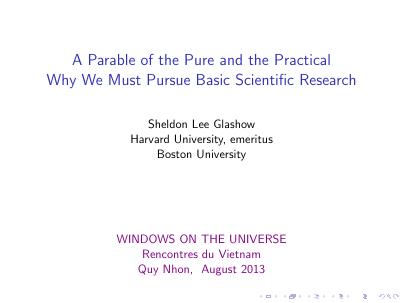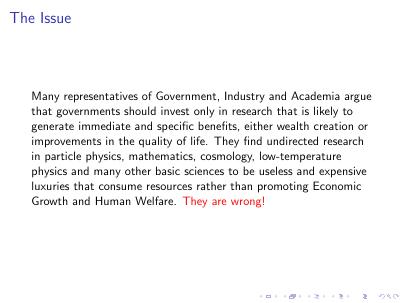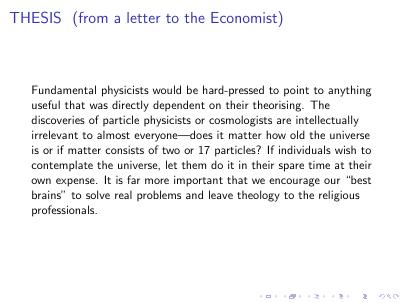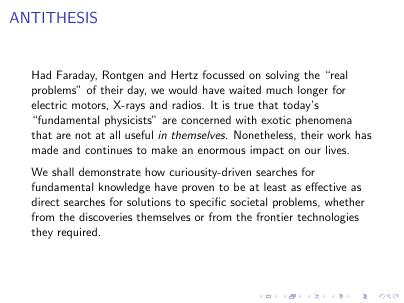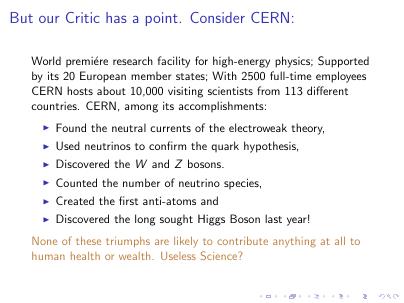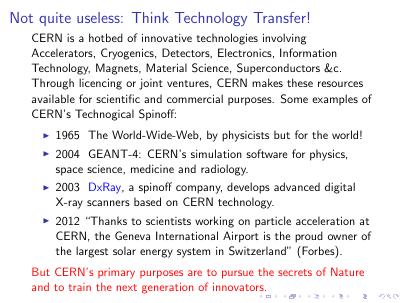环形正负电子对撞机.pdf
A Parable of the Pure and the Practical Why We Must Pursue Basic Scientific Research Sheldon Lee Glashow Harvard University, emeritus Boston University WINDOWS ON THE UNIVERSE Rencontres du Vietnam Quy Nhon, August 2013 The Issue Many representatives of Government, Industry and Academia argue that governments should invest only in research that is likely to generate immediate and specific benefits, either wealth creation or improvements in the quality of life. They find undirected research in particle physics, mathematics, cosmology, low-temperature physics and many other basic sciences to be useless and expensive luxuries that consume resources rather than promoting Economic Growth and Human Welfare. They are wrong! THESIS (from a letter to the Economist) Fundamental physicists would be hard-pressed to point to anything useful that was directly dependent on their theorising. The discoveries of particle physicists or cosmologists are intellectually irrelevant to almost everyone—does it matter how old the universe is or if matter consists of two or 17 particles? If individuals wish to contemplate the universe, let them do it in their spare time at their own expense. It is far more important that we encourage our “best brains” to solve real problems and leave theology to the religious professionals. ANTITHESIS Had Faraday, Rontgen and Hertz focussed on solving the “real problems” of their day, we would have waited much longer for electric motors, X-rays and radios. It is true that today’s “fundamental physicists” are concerned with exotic phenomena that are not at all useful in themselves. Nonetheless, their work has made and continues to make an enormous impact on our lives. We shall demonstrate how curiousity-driven searches for fundamental knowledge have proven to be at least as effective as direct searches for solutions to specific societal problems, whether from the discoveries themselves or from the frontier technologies they required. But our Critic has a point. Consider CERN: World premiére research facility for high-energy physics; Supported by its 20 European member states; With 2500 full-time employees CERN hosts about 10,000 visiting scientists from 113 different countries. CERN, among its accomplishments: I Found the neutral currents of the electroweak theory, I Used neutrinos to confirm the quark hypothesis, I Discovered the W and Z bosons. I Counted the number of neutrino species, I Created the first anti-atoms and I Discovered the long sought Higgs Boson last year! None of these triumphs are likely to contribute anything at all to human health or wealth. Useless Science? Not quite useless: Think Technology Transfer! CERN is a hotbed of innovative technologies involving Accelerators, Cryogenics, Detectors, Electronics, Information Technology, Magnets, Material Science, Superconductors &c. Through licencing or joint ventures, CERN makes these resources available for scientific and commercial purposes. Some examples of CERN’s Technogical Spinoff: I 1965 The World-Wide-Web, by physicists but for the world! I 2004 GEANT-4: CERN’s simulation software for physics, space science, medicine and radiology. I 2003 DxRay, a spinoff company, develops advanced digital X-ray scanners based on CERN technology. I 2012 “Thanks to scientists working on particle acceleration at CERN, the Geneva International Airport is the proud owner of the largest solar energy system in Switzerland” (Forbes). But CERN’s primary purposes are to pursue the secrets of Nature and to train the next generation of innovators. The Many Virtues of Basic Science: I. Clinical Medicine I 1894 X-Rays I CAT Scanners I 1932 Antimatter I PET Scanners I 1950 Nuclear Magnetism I MRI Scanners I 1912 Radioactive Isotopes I Brachytherapy I 1934 Cyclotron I Particle Beam Therapy I 1957 Lasers I Microsurgery I 1986 PCR I Forensic Medicine I 1928 Penicillin (by Chance!) I Disease Control I 1953 DNA Structure I Gene Therapy Each of these discoveries earned a Nobel Prize! II. Basic Science and Information Technology I 1888 Radio Waves I Wireless Transmission I 1947 Holography I Secure Credit Cards I 1947 Transistors I 1st Computer Revolution I 1951 Integrated Circuits I 2nd Computer Revolution I 1966 Optical Fibers I Rapid Data Transmission I 1976 PK Cryptography I Secure Data Transmission I 1988 Giant Magnetoresistance I Disk Readout I 1986 High T Superconductors I Energy Storage (?) I 2012 Quantum Manipulation I Quantum Computers (?) All but two of these discoveries earned Nobel Prizes! III. Yet More Fruits of Basic Science I 1839 Photovoltaic Effect I Solar Panels I 1905 Photoelectric Effect I Charge Coupled Device I 1912 X-Ray Diffraction I DNA Structure I 1916 General Relativity I Global Positioning I 1938 Nuclear Fission I Nuclear Power I 1949 Carbon Dating I Climate Research I 1969 Charge Coupled Device I Digital Cameras I 1985 Bucky-Balls (Fullerenes) I ? I 2004 Graphene I ? All but one of these discoveries earned Nobel Prizes! How ‘Atom Smashers’ Became Big Business Cyclotrons were created for pure research: to study the basic building blocks of matter. But these and other particle accelerators contribute directly to wealth creation and human welfare. Some 30,000 accelerators operate today. Very few do fundamental research. Mostly they are used for industry and medicine: Ion Implantation, Material Processing, Particle Beam Therapy, Medical Isotope Production, Food Irradiation, Nondestructive Inspection etc. Energy loss due to ‘synchrotron radiation,’ once a problem at electron accelerators, has become a multi-billion dollar bounty. Synchrotron light is useful for many basic sciences, medicine and industry. About 70 of these large, expensive and sophisticated light sources are deployed in 20 countries. Far more powerful ‘Fourth Generation’ light sources are on the horizon. Between Idea and Implementation I GMR Effect to Gigabyte Hard Drives: I 3 years I CCD to Digital Camera: I 6 years I Transistor to Transistor Radio: I 7 years I Radio Waves to Wireless Telegraphy: I 11 years I Fission to Nuclear Power: I 19 years I General Relativity to Global Positioning: I 78 years I Photovoltaics to Solar Panels: I 115 years The latency period have can various causes, among them: Necessity (e.g., solar panels); War (e.g., nuclear power); or Missing Technology (e.g., GPS needs satellites and sophisticated electronics as well as general relativity.) La Chance ne sourit qu’aux esprit bien préparé, Research must be done with eyes wide open Five Very Short Stories I Once upon a time a Prince searched for a needle in a haystack. Instead he found the farmer’s daughter. I In 1856 young Henry Perkin to tried to synthesize quinine. Instead, he discovered the first aniline dye. I In 1896 Henri Becquerel set out to prove that the sun emits X-rays. Instead, he discovered radioactivity. I In 1965 a chemist was assessing the efficacy of an anti-ulcer medication. Instead he stumbled upon the blockbuster artificial sweetener aspartame. I In 1996, chemists at Pfizer held clinical trials for a new drug to treat angina and hypertension. The trials failed, but an entirely unanticipated side effect on men led Pfizer to market Viagra for male impotence. International Scientific Cooperation A Paradigm for Peace among Nations Basic scientific research is among the few areas wherein nations of the world cooperate. Modern science emerged as an multinational endeavor: Copernicus (a Pole), Tycho Brahe (a Dane), Kepler (a German), Galileo (an Italian) and Newton (an Englishman) taught us our place in the heavens. Whilst these were all white, Christian, European men, today everyone can contribute to the Scientific Adventure regardless of nationality, religion, race or sex. Among many international collaborations: I Alpha Magnetic Spectrometer: 16 nations I International Space Station: 15 nations I International Linear Collider: 19 nations I ITER (Thermonuclear Research): EU + six nations I CERN: Scientists from over 100 nations States with Formal Contacts with CERN Algeria, Argentina, Armenia, Australia, Austria, Azerbaijan, Belarus. Belgium, Bolivia, Brazil, Bulgaria, Canada, Chile, China, Colombia, Croatia, Cuba, Cyprus, Czech Republic, Denmark, Ecuador, Egypt. Estonia, France, Finland, Georgia, Germany, Ghana, Greece, Hungary, Iceland, India, Iran, Ireland, Israel, Italy, Japan, Jordan, Korea, Latvia, Lebanon, Lithuania, Macedonia, Madagascar, Malaysia, Malta, Mexico, Montenegro, Mozambique, New Zealand, Netherlands, Norway, Pakistan, Palestine, Peru, Philippines, Poland, Portugal, Qatar, Romania, Russia, Rwanda, Saudi Arabia, Singapore, Slovenia, Slovak Republic, South Africa, Spain, Sri Lanka, Sweden, Switzerland, Taiwan, Thailand, Tunisia, Turkey, United Arab Emirates, United Kingdom, Ukraine, USA, Uzbekistan, Venezuela, Vietnam. Five (of Many) Physicists Who Spun Themselves Off I Allan Cormack: Nuclear and particle physicist, longtime chairman Tufts physics dept., invented the CAT scanner for which he won the Nobel Prize in Medicine. I Walter Gilbert: Accomplished theoretical physicist became molecular biologist, shared Nobel in Chemistry, cofounder & first CEO Biogen, now celebrated art photographer & philanthropist. I Paul Ginsparg: Theoretical physicist and IT expert, founder of the free online archive for physics and many other sciences. Won MacArthur award for “changing how physics gets done.” I Leon Lederman: Experimental physicist, codiscovered second neutrino & fifth quark, Nobelist, many STEM initiatives, e.g., creating the Illinois Math & Science Academy. I Andrei Sakharov: Famed Soviet theoretical physicist. human rights champion and Nobel Laureate in Peace, led his government to sign nuclear test ban treaty. Technology Impacts Basic Science! I Steam engines were invented long before they could be understood, thus challenging physicists to develop the science of thermodynamics. I The 19th century inventions of spark coils (by Ruhmkorff), photography (by Daguerre) and mercury air pumps (by Geissler) made many turn-of-the-century discoveries possible: radio waves, X-rays, radioactivity, the electron, atomic number, cathode ray tubes.... I The antenna used by Penzias and Wilson to discover the cosmic microwave background was built by ATT for early satellite communication. I Mysterious gamma-ray bursts were detected by US Air Force satellites looking for illicit Soviet nuclear tests. I Supercomputers enable otherwise impossible calculations in both pure and applied science, e.g., the four color theorem.

 环形正负电子对撞机.pdf
环形正负电子对撞机.pdf